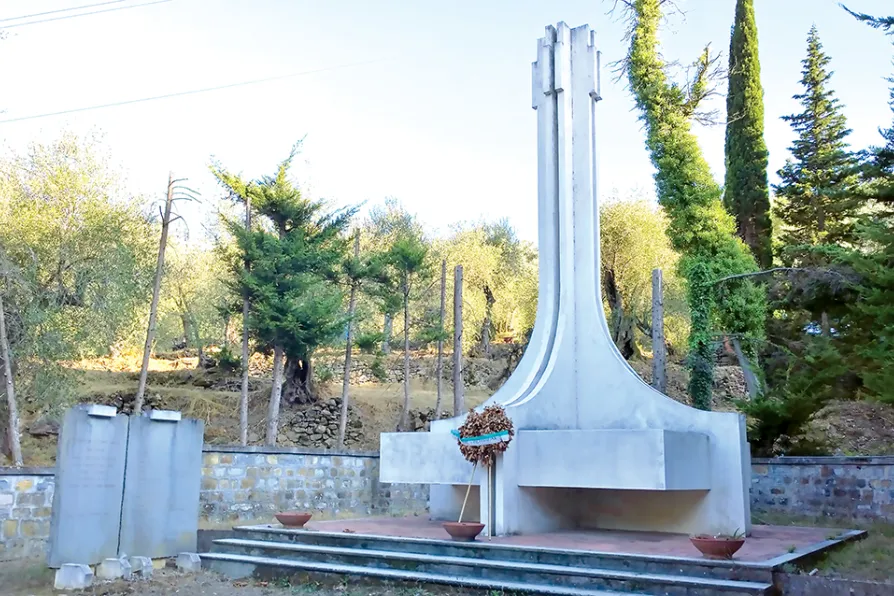From London’s holly-sellers to Engels’s flaming Christmas centrepiece, the plum pudding was more than festive fare in Victorian Britain, says KEITH FLETT
KEVIN DONNELLY reports from Monte Faudo and its annual remembrance of the region’s WWII partisan anti-fascist battles

 The Torre Paponi memorial
The Torre Paponi memorial
IN BERNARDO Bertolucci’s epic drama Novecento (1900), the film is bookended by two major segments set on April 25 1945 — Liberation Day.
It reflects the importance this day holds in the Italian political and cultural imagination; and continues to do so thanks to the efforts of volunteers and organisations such as ANPI (Associazione Nazionale Partigiani d’ Italia / National Association of Italian Partisans).
This year is the 80th anniversary and I was invited to an event marked by theatre, song — and of course pranzo (lunch) — at Casone dei Partigiani del Monte Faudo, the Partisan House, which was used during the war as a base. Set on the slopes of a mountain, It is now a museum containing numerous photographs, artefacts and documents.
The national and regional history of the resistance has been well documented — the latter, for example, in the multivolume Storia Della Resistenza Imperiese / History of the Resistance in Imperia, but what of the local stories?
One problem of course is that all the partisans in this region are now sadly gone, but the folk memory of these events lives on with their families.
Take Fulvia from Pietrabruna, for example. Her father Carluccio (“Alvaro”) was a partisan who took part in the Battle of Santa Brigida on September 4 1944. During this, 18 partisans from the “Pancho” detachment, 4th brigade, engaged with a force of 200 Nazis and fascists from “Arditi” units, inflicting heavy casualties on the enemy. Carluccio’s best friend Tunin (“Castor”) was killed standing right beside him.
There are also websites such as “Pietrabruna Me Amu” (Pietrabruna I Love You, in dialect) set up to capture and keep alive local stories, anecdotes and the traditions of the municipality; and much of this relates to the resistance.
For instance, here you can find letters from wives to their husbands in the resistance and stories about villagers sheltering partisans.
On this website you can also find information about the tragedies which befell the area during these dark times. For example, between December 13-16 1944, the Nazis carried out a “rastrellamento” (search) in the village of Torre Paponi (part of the Pietrabruna municipality) during which 28 of the villagers were brutally murdered, including the local priests, who were locked in a barn with others and burned to death.
Further, on the August 17 1944 the “Eccido di Monte Faudo” took place with 13 agricultual workers murdered in a meadow near the summit of the mountain. This included Pippo, the brother of Tunin who died at Santa Brigida — where a ceremony is held commemorating the “eccido” each year.
There are also those still alive today who remember, as children, being locked up with others in the church at Pietrabruna by the SS, but who for some reason where spared the ordeal suffered by Torre Paponi.
Back at the event on Friday, I was briefly able to interview Roberto Moriani, the vice-president of ANPI Imperia, president of the Casone, who is also involved with maintaining the archives at ISREC (Istituto Storico della Resistenza e dell’ eta Contempora) in Imperia.
I started by asking Moriani about the challenges keeping the legacy of the resistance alive in the current political climate. He was keen to stress that this was a national event and therefore should be supported by a national government of whatever persuasion; and therein lay the contradiction, as the current political regime were trying to diminish its importance nationally.
An example of this was the right-wing mayor of Ospedaletti — a town up the coast from Sanremo — attempting to ban the singing of Bella Ciao on Friday as it was a “leftist” song (technically it’s not, it’s anti-fascist). Not an isolated incident this year it seems, but fortunately he didn’t succeed and ended up singing along to it with everyone else!
Moriani also succinctly hit the nail on the head as regards the main motivation for this: “This day represents the date of their defeat!” He is also confident that, in their bid for hegemony, the far right will not succeed and history will not be rewritten.
Walking out into the bright sunshine, he said: “Look around you, there are a lot of good people.” Probably over 200 at my estimate, many trekking up a mule track to be here (including me!).
So, what of the future? The partisans themselves used to be a very important and active part of projects in local schools but, as mentioned earler, they have now all gone. However, local young people have been involved in producing a comic strip about the resistance and this was on display around the casone on Friday.
La lotta continua!

The Morning Star's Danish sister paper ARBEJDEREN on when the people of Copenhagen triumphed over the occupying forces

The annual commemoration of anti-fascist volunteers who fought fascism in Spain now includes a key contribution from Italian comrades











